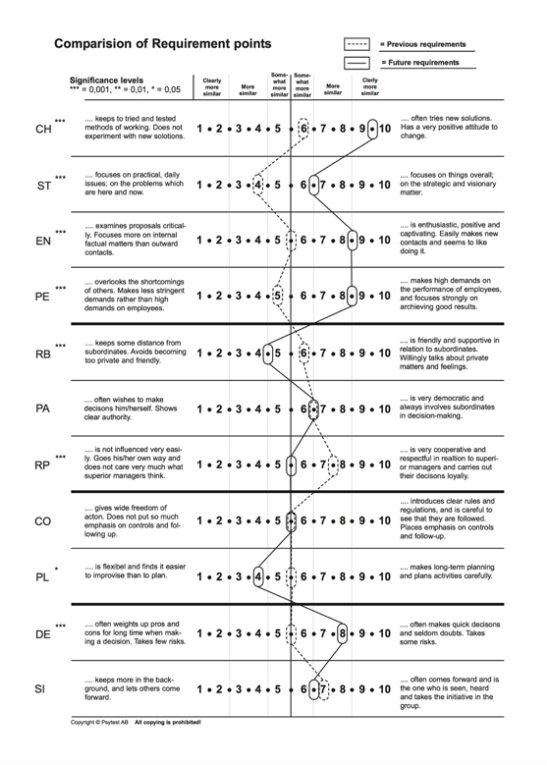The survey was conducted in a major Swedish company during a pronounced and extensive period of change. About 40 managers had to complete a modified requirement analysis twice. In the first requirement analysis, the managers stated how they felt about demands on their leadership style until the present. In the second requirement analysis, they stated how they felt that the demands on their leadership style would be from this point forward. A 10-degree scale was used for the assessments, in which the measurement scales’ dimensions corresponded to the LSI test (Leadership Style Inventory). (In the survey, it was the first version of the LSI test that was used. It differs in some ways from the LSI version II that is used today).
The result of the survey is shown below.

The dotted line reflects the average of the managers’ assessments of the demands set so far (i.e., previously set demands) in their leadership style, and the solid line reflects the average of the managers’ assessments of future demands on their leadership style. As the organization was in a very clear transition phase, it can be assumed that the differences between previous and future demands reflect the demands the managers felt they faced at conversion/change compared to the demands placed on them in a more calm, controlled period.
The results show that managers on all scales associated with Changing Leadership Style (ie, CH: Change, ST: Strategy, EN: Enthusiasm and PE: Performance) expect significantly higher requirements in the future.
Significant differences between past and future demands also reflect increased demands for DE: Decisiveness, lower demands for RB: Relations subordinates and RP: Relations superiors and lower demands for PL: Planning (the latter is weakly significant). This means that if it was previously good to nurture warm and conflict-free relationships with superiors, follow plans and take great care of the relationships with subordinates, and exercise great care in decision making, it will be good in the future to be more courageous and to dare to make uncomfortable decisions and spend less time on planning.
Conclusions
What recommendations can be made for the recruitment and training of managers based on these results? The results indicate that if managers are to be prepared to deal with profound changes, they need more of a changeable attitude (CH). They need to transcend the daily routines (ST) and motivate employees with enthusiasm and self-esteem (EN). They also need to set higher performance requirements (PE). These are all aspects of a Changing leadership style. In addition, the results show that managers feel a need to be “tougher”: to confront conflicts and show greater determination/courage. These are, in any case, behavioral areas that many executives feel need to be strengthened, and it may be wise to develop them in managers if you know that the demands to make radical changes will be great in the future.
In terms of recruitment, these results (and also others) show that the Change leadership style and that the sub-scales CH: Change and EN: Enthusiasm are assets when there is a high demand to drive changes. Even DE: Decisiveness can be an interesting scale to look at more closely.
During the autumn, Psytest AB will publish a number of survey results about leadership. The surveys are presented in more detail in a dissertation by Stefan Lindstam (see amazon.de, “The FSI Führungsstilinventar und das integrative Führungsmodell”, 2015). The dissertation is written in German, although it is based on Swedish surveys. In order to give readers easier access to these results, this article series consists of shortened and simplified presentations of selected survey results in English. The surveys are made by using the LSI Leadership Style Inventory Test. The underlying leadership style model is broad and general (compare the Big Five model within the personality field) and the conclusions are therefore generally relevant to people working in the field of management recruitment and leadership development.
